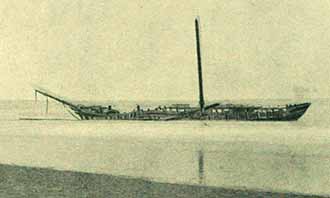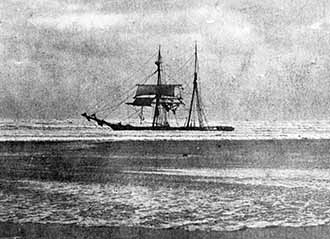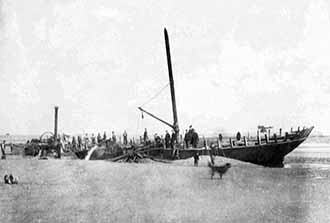Wreck of the Constance Ellen
3½ Hours Battling with the Storm
A watch was kept by the Lifebrigadesmen at the South Pier throughout the day, although it was not until nearly six in the evening that their services were requisitioned. Darkness had then fallen upon the scene and the lights of one or two vessels were seen off the harbour, and were closely watched from the tower of the Brigade House. The men began to muster in goodly numbers, and at one part or another of the night the whole of the captains, Messrs J. W. Buckland, J. Page, T. B. Grimes, and G. Ogilvie kept duty.
A little before six o'clock the lights of a small craft were seen making for the beach. It was thought at first she had mistaken the harbour lights but subsequent events shewed that the vessel was helplessly driven before the storm. It was soon inevitable that she was a doomed ship, and she came straight in through the surf, and stranded almost opposite the lifeboat house on the south side of the pier. The point she struck was almost precisely where the ill-fated Olaf Kyrre was wrecked in 1882.
The distress signals were fired, and immediately the heavy artillery of the Andromache resounded through the harbour boroughs, telling the tale of shipwreck. It was at an hour when it seemed everybody was at liberty to leave their homes for in an incredibly short time the main thoroughfare leading to the pier was thronged with people, harrying and jostling their way to the scene of the disaster. It required a doughty heart and a tough skin to face the fill blast of the storm. Occasionally, the blinding showers of rain and sand completely baffled the efforts of the pedestrian who had to pull up at the rails or seek some temporary shelter till the squall had spent itself. It was therefore a herculean task which the Coastguard and the Life Brigade had to face.
The cart containing the apparatus was taken down to the beach where in a very short time the rescuers were largely reinforced by other members of the Brigade. Thousands of people congregated and watched the operations with thrilling interest. The stranded vessel was plainly seen in the boiling surf which sometimes washed right over her, but her position, owing to her being on a sandy bottom and with a receding tide, did not give cause for immediate alarm. Occasionally the men on hoard burnt a flare light, which enabled the spectators to easily discern the sails of the vessel torn in shreds. Ten minutes went by before the first rocket was fired, and although it made steady in the direction of the ship, the hurricane wind carried the line out of reach. Then followed long and tedious waits between the second, third, and fourth shots being fired, all of which fell short or went wide of the mark.
The operations of the brigadesmen were hampered and delayed by an alarm that was raised pretty universally to the effect that another vessel had gone ashore near the Trow Rocks. Considerable colour was given to the rumour by occasional flashes of light in that direction, which were naturally construed to be the distress signals of a vessel. Accordingly the rescuing forces were divided, and one body was told off with the cart, containing a full set of gear. They proceeded along the beach, and scanned the coast line in vain for any sight of the reported wreck. Some wreckage cast up near the Trow Rocks, which led to the belief in the minds of many that a vessel had gone down with all hands, but they could only wait for the morning for further evidence of the calamity, if such it was. This fruitless expedition occupied nearly an hour, and on their returning a second alarm reached them of a wreck on the Herd Sands.
This unfortunately proved to be only too true, and a number of men were despatched to the scene of the fresh disaster. Meanwhile the brigadesmen stood to their post of duty, facing the full fury of the wind and rain, and occasionally standing up to their waists in the breakers on the shore. The fourth rocket had gone the way of the others, but Chief Coastguardsman Williams succeeded in establishing communication with the fifth, which passed right over the ship One of the crew climbed to the topsail yard for the line, but there was either some hitch in the arrangements or the crew did not understand how to manipulate the apparatus, for another long delay ensued. The rescuers on shore seemed, under the circumstances, helpless to save the men. Nearly three hours had now gone by since the stranding, and the tide had considerably receded, leaving the vessel almost within hailing distance. A man named Dick Wilson, a well-known local athlete, waded into the surf and pluckily attempted to swim with a line to the vessel, but no human being could live in such a sea, and he had to return fatigued and overcome with his exertions. He was taken to the Brigade House, where be evidently relished a hot cup of coffee which was served out to him.
The brigadesmen ran imminent risks too, in their endeavours to get as near as possible to the vessel. Occasionally they were buried overhead in the surf, but never for a moment relinquished their efforts. At last a stout line was made fast to the ship, and held taut. For some reason, probably the men's lack of knowledge, the breeches buoy was never used, and one after another the hands came ashore suspended in a bowling knot on the hawser. They were dragged through the boiling seas and reached terra firma in a more or less benumbed and comatose state. But there were plenty of willing and strong arms to receive them, and each man as he came ashore was assisted to the Brigade House where dry clothing was provided, and where he came under the kindly attention of Dr Crease the hon. surgeon of the Brigade, and Nurse O'Neill, of the South Shields Nursing Division of the St. John Ambulance Association.
The stranded vessel proved to be the barquentine Constance Ellen from Littlehampton to Bo'ness in Scotland, with iron rails. She was in charge of Captain Robinson and left Littlehampton on Friday last. The vessel fell in with bad weather yesterday, and made for the Tyne. The fore topsail, staysail, and jib were blown away, and other damage sustained from the stress of weather.
Source: Shields Daily Gazette 13 November 1901
At the south side of the Pier the Constance Ellen which was the first vessel ashore, is deeply embedded in the sand. She is evidently a tight little craft, for in spite of the terrible buffetting she has received she remains almost intact. Her bulwarks have been torn away and her sails are lying in tatters, but her masts and hull have successfully weathered the gale. She is an object of rare interest to visitors.
Source: Shields Daily Gazette 14 November 1901
THANKS TO THE LIFE BRIGADE.
(To the Editor of the "Shields Gazette.")Sir,- The master the Constance Ellen, which was wrecked at the back of the South Pier on Tuesday night, desires with his relatives to express keen and grateful appreciation of the gallant services rendered by the South Shields Volunteer Life Brigade and others, which after three hours of strenuous exertions, resulted in the saving of the entire crew of seven men.—Yours, etc,
Louis Henry Robinson,
Late master of Constance Ellen.
Source: Shields Daily Gazette 19 November 1901
BRIGANTINE
CONSTANCE ELLEN
of Littlehampton
as she now lies on the Beach at South Shields
VASEY & READ
Auctioneers and Valuers
Are instructed to SELL BY PUBLIC AUCTION, on THURSDAY FIRST on the 21st inst. at 1.30 o’clock prompt in the Afternoon the above Vessel as she now lies. She was re-classed at Lloyds in September last.
The whole of the Stores including New Sail, Tow Line etc. will also be sold in suitable lots.
Auction Offices:
25 King Street, South Shields
Source: Shields Daily Gazette 20 November 1901


